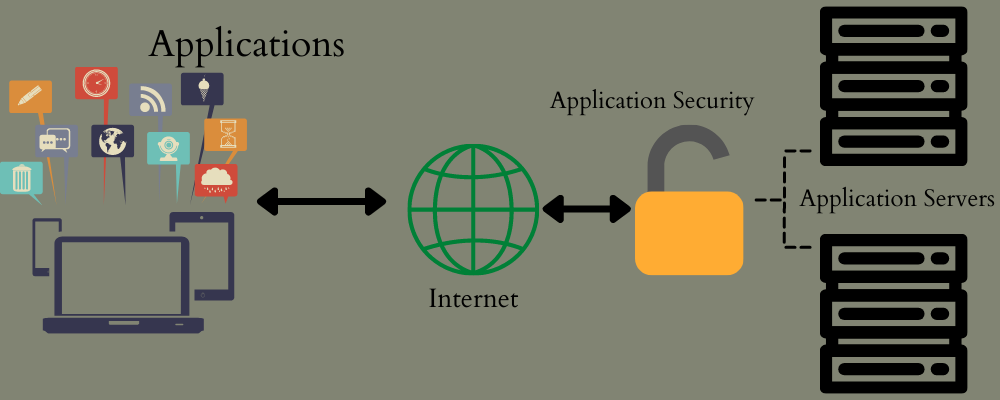Application security testing is essential to ensure your application is free from vulnerabilities and risks and reduce the attack surface to prevent cyber attacks.
A report says businesses suffered 50% more cyber attacks in 2021 every week. All types of businesses are under the attackers’ radar, including education institutions, government organizations, healthcare, software vendors, finance, and more.
Needless to say, applications are widely used in almost every sector to make it easier and convenient for people to use products and services, consultations, entertainment, etc. And if you are building an application, you must check for its security starting from the code phase to production and deployment.
SAST and DAST are two excellent ways to perform application security testing.
While some prefer SAST, others prefer DAST, and some also like both in conjugation.
So, which side are you on? If you can’t decide, let me help you!
In this article, we will do a SAST vs. DAST comparison to understand which is better for what case. It will help you choose the best one based on your testing requirements.
So, stay tuned to know who wins this battle!
SAST vs. DAST: What Are They?

If you want to understand the difference between SAST and DAST, it’s essential to clarify some basics. So, let’s know what SAST and DAST are.
What’s SAST?
Static Application Security Testing (SAST) is a testing method to secure an application by reviewing its source code statistically to identify all the vulnerability sources, including application weaknesses and flaws like SQL injection.
SAST is also known as “white-box” security testing, where the application’s internal parts are analyzed thoroughly to find the vulnerabilities. It is done in the early stages of application development at the code level before the build’s completion. It can also be done after the application’s components are combined in a testing environment. In addition, SAST is used for an application’s quality assurance.
Furthermore, it is performed using SAST tools, focusing on an application’s code content. These tools scan the app’s source code, along with all its components, to find potential security issues and vulnerabilities. They also help reduce downtimes and risks of getting data compromised.
Some of the excellent SAST tools available in the market are:
What’s DAST?
Dynamic Application Security Testing (DAST) is another testing method that uses a black-box approach, assuming the testers don’t have access or knowledge of the application’s source code or its inner functionality. They test the application from outside using the available outputs and inputs. The test resembles a hacker trying to gain access to the application.
DAST aims to observe the application’s behavior to attack vectors and identify vulnerabilities remaining in the application. It is done on a functioning application and needs you to run the application and interact with it to implement some techniques and perform assessments.
Performing DAST helps you detect all the security vulnerabilities in your application in runtime after its deployment. This way, you can prevent a data breach by reducing the attack surface through which real hackers can pull a cyberattack.
Moreover, DAST can be done both manually and using DAST tools to implement a hacking method such as cross-site scripting, SQL injection, malware, and more. DAST tools can check authentication issues, server configuration, logic misconfigurations, third-party risks, encryption insecurities, and more.
Some of the DAST tools you can consider are:
SAST vs. DAST: How They Work

How Does SAST Work?
Firstly, you must choose a SAST tool to implement on your application’s build system to perform the testing. So, you must select a SAST tool based on some criteria, such as:
- The application’s programming language
- The tool’s compatibility with current CI or any other development tools
- The application’s accuracy in finding issues, including the number of false positives
- How many types of vulnerabilities can the tool cover, along with its ability to check for custom criteria?
So, once you have chosen your SAST tool, you can proceed with it.
SAST tools work something like this:
- The tool will scan the code at rest to have a detailed view of the source code, configurations, environment, dependencies, data flow, and more.
- The SAST tool will check the app’s code line-by-line and instruction-by-instruction while comparing them against set guidelines. It will test your source code to detect vulnerabilities and flaws, such as SQL injections, buffer overflows, XSS issues, and other problems.
- The next step in SAST implementation is code analysis through SAST tools using a set of rules and customizing them.
Thus, detecting issues and analyzing their impacts will help you plan out how to fix those issues and improve the application’s security.
However, SAST tools can give false positives, so you must have good knowledge of coding, security, and design to detect those false positives. Or, you can make some changes to your code to prevent false positives or reduce them.
How Does DAST Work?
Similar to SAST, ensure to choose a good DAST tool by considering some points:
- DAST tool’s level of automation to schedule, run, and automate manual scans
- How many types of vulnerabilities can the DAST tool cover?
- Is the DAST tool compatible with your current CI/CD and other tools?
- How much customization does it offer to configure it for a specific test case?
Usually, DAST tools are effortless to use; but they do a lot of complex stuff behind the scenes to make the testing easy.
- DAST tools aim at collecting as much data as possible about the application. They crawl each page and extract inputs to enlarge the attack surface.
- Next, they begin scanning the application actively. A DAST tool will send various attack vectors to endpoints found previously to check for vulnerabilities like XSS, SSRF, SQL injections, etc. Also, many DAST tools allow you to create custom attack scenarios to check for more issues.
- Once this step is complete, the tool will display the results. If it detects a vulnerability, it immediately gives comprehensive information about the vulnerability, its type, URL, severity, attack vector and helps you fix the issues.
DAST tools work excellent at detecting authentication and configuration issues occurring while logging in to the application. They provide specific predefined inputs to the application under test to simulate attacks. The tool then compares the output against the expected result to find flaws. DAST is widely used in web application security testing.
SAST vs. DAST: Why You Need Them
SAST and DAST both offer many advantages to development and testing teams. Let’s look at them.
Benefits of SAST
Ensures Security in the Early Stages of Development
SAST is instrumental in ensuring an application’s security in the early stages of its development lifecycle. It enables you to find vulnerabilities in your source code during the coding or designing stage. And when you can detect issues in the early stages, it becomes easier to fix them.

However, if you don’t perform tests early to find issues, leaving them to keep building on until the end of development, the build can have many inherent bugs and errors. Hence, it will become not only problematic to understand and treat them but also time-consuming, which further pushes your production and deployment timeline.
But performing SAST will save you time and money fixing the vulnerabilities. Plus, it can test both server-side and client-side vulnerabilities. All these help secure your application and enable you to build a safe environment for the application and deploy it quickly.
Faster and Precise
SAST tools scan your application and its source code thoroughly faster than manually reviewing code. The tools can scan millions of code lines quickly and precisely and detect underlying issues in them. In addition, SAST tools continuously monitor your code for security to preserve its integrity and functionality while helping you mitigate issues quickly.
Secure Coding
You must ensure secure coding for every application, whether developing code for websites, mobile devices, embedded systems, or computers. When you create robust, safe coding from the beginning, you reduce the risks of getting your application compromised.
The reason is attackers can easily target poorly coded applications and perform harmful activities like stealing information, passwords, account takeovers, and more. It poses adverse effects on your organizational reputation and customer trust.
Using SAST will help you ensure safe coding practice from the start and give it a solid base to flourish in its lifecycle. It will also help you ensure compliance. In addition, Scrum masters can use SAST tools to ensure safer coding standard is being implemented in their teams.
High-Risk Vulnerability Detection

SAST tools can detect high-risk application vulnerabilities like SQL injection that could affect an application throughout its lifecycle and buffer overflows that can disable the application. In addition, they efficiently detect cross-site scripting (XSS) and vulnerabilities. In fact, good SAST tools can identify all the issues mentioned in OWASP’s top security risks.
Easy to Integrate
SAST tools are easy to integrate into an existing process of an application development lifecycle. They can seamlessly work within development environments, source repositories, bug trackers, and other security testing tools. They also include a user-friendly interface for consistent testing without a steep learning curve for users.
Automated Audits
Manual code audits for security issues can be tedious. It requires the auditor to understand the vulnerabilities before they can actually jump on to examine the code thoroughly.
However, SAST tools offer incredible performance to examine code frequently with accuracy and less time. The tools can also enable code security more efficiently and accelerate code audits.
Benefits of Using DAST
DAST focuses on an application’s runtime features, offering a lot of benefits to the software development team, such as:
Wider Scope of Testing
Modern applications are complex, including many external libraries, legacy systems, template code, etc. Not to mention, security risks are evolving, and you need such a solution that can offer you broader testing coverage, which might not be enough if you just use SAST.
DAST can help here by scanning and testing all types of applications and websites, regardless of their technologies, source code availability, and origins.

Therefore, using DAST can address various security concerns while checking how your application appears to attackers and end-users. It will help you run a comprehensive plan to fix the issues and produce a quality application.
High Security Across Environments
Since DAST is implemented on the application from the outside, not on its underlying code, you can achieve the highest level of security and integrity of your application. Even if you make some changes in the application environment, it remains secure and fully usable.
Tests Deployments
DAST tools are not only used to test applications in a staging environment for vulnerabilities but also during development and production environments.
This way, you can view how secure your application is after production. You can scan the application periodically using the tools to find any underlying issues brought about by configuration changes. It can also discover new vulnerabilities, which can threaten your application.
Easy to Integrate into DevOps Workflows
Let’s bust some myths here.
Many think that DAST can’t be used during the development stage. It was but no longer valid. There are many tools such as Netsparker that you can easily integrate into your DevOps workflows.

So, if you set the integration right, you can enable the tool to scan for vulnerabilities automatically and identify security problems in the early stages of application development. This will better ensure the application’s security, avoid delays while finding and addressing issues, and reduce related expenses.
Helps in Penetration Testing
Dynamic application security is like penetration testing, where an application is checked for security vulnerabilities by injecting a malicious code or running a cyberattack to check the application response.
Using a DAST tool in your penetration testing efforts can simplify your work with its comprehensive capabilities. The tools can streamline the overall penetration testing by automating the process of identifying vulnerabilities and reporting issues to fix them immediately.
Broader Security Overview
DAST has an advantage over point solutions since the former can thoroughly review your application’s security posture. It can also test all types of applications, sites, and other web assets irrespective of their programming languages, origins, course code, etc.
Hence, no matter what type of software or application you build, you can comprehensively understand its security status. As a result of greater visibility across environments, you can even detect risky outdated technologies.
SAST vs DAST: Similarities and Differences
Static Application Security Testing (SAST) and Dynamic Application Security Testing (DAST) are both a type of application security testing. They check applications for vulnerabilities and issues and help prevent security risks and cyberattacks.
Both SAST and DAST have the same purpose – to detect and flag security issues and help you fix them before an attack can happen.
Now, in this SAST vs DAST tug of war, let’s find some of the prominent differences between these two security testing methods.
| Parameter | SAST | DAST |
| Type | White-box application security testing. | Black-box application security testing. |
| Testing Pathway | Testing is performed from the inside out (of the applications). | Testing is performed from the outside in. |
| Approach | Developers’ testing approach.
Here, the tester knows about the application’s design, implementation, and framework. |
Hackers’ approach.
Here, the tester knows nothing about the application’s design, implementation, and frameworks. |
| Implementation | It is implemented on static code and requires no deployed applications. It is called “static” because it scans the application’s static code to test for vulnerabilities. | It is implemented on a running application. It is called “dynamic” since it scans the application’s dynamic code while it’s running to find vulnerabilities. |
| Timeline | SAST is done in the early stages of application development. | DAST is done on a running application towards the end of an application development lifecycle. |
| Coverage and analysis | It can find client-side and server-side vulnerabilities with accuracy. SAST tools are compatible with various embedded systems and code.
However, it can’t detect issues related to environments and runtime. |
It can detect issues related to environments and runtime. But it can only analyze responses and requests in an application. |
| Source code | It needs source code for testing. | It doesn’t require source code for testing. |
| CI/CD pipelines | SAST is integrated into CI/CD pipelines directly to help developers monitor the application code regularly.
It covers every stage of the CI process, including security analysis for the app’s code via automated code scanning and testing the build. |
DAST is integrated into a CI/CD pipeline after the app is deployed and running on a test server or the developer’s computer. |
| Risk mitigation | SAST tools scan code thoroughly to find vulnerabilities with their accurate locations, which helps in easier remediation. | Since DAST tools work during runtime, they may not provide the accurate location of vulnerabilities. |
| Cost-efficiency | As issues are detected in the early stages, fixing those issues is easy and less expensive. | Since it is implemented towards the end of the development lifecycle, issues can’t be detected until then. Also, it might not provide accurate locations.
All these make it expensive to fix issues. At the same time, it delays the overall development timeline, increasing overall production costs. |
SAST vs. DAST: When to Use Them
When to Use SAST?
Suppose you have a development team for writing code in a monolithic environment. Your developers incorporate changes to the source code as soon as they come up with an update. Next, you compile the application and regularly promote it to the production stage at a scheduled time.
Vulnerabilities won’t surface much here, and when it does after a considerably long time, you can review and patch it. In this case, you may consider using SAST.
When to Use DAST?
Suppose you have an effective DevOps environment with automation in your SLDC. You can leverage containers and cloud platforms like AWS. So, your developers can quickly code their updates and use DevOps tools to compile the code automatically and generate containers quickly.
This way, you can accelerate deployment with continuous CI/CD. But this may also increase the attack surface. For this, using a DAST tool could be an excellent choice for you to scan the complete application and find issues.
SAST vs. DAST: Can They Work Together?
Yes!!!
In fact, using them together will help you understand security issues comprehensively in your application from inside out to outside in. It will also enable a synbiotic DevOps or DevSecOps process based on effective and actionable security testing, analysis, and reporting.
Furthermore, this will help reduce the vulnerabilities and attack surface and mitigate cyberattack concerns. As a result, you can create a highly secure and robust SDLC.

The reason is “static” application security testing (SAST) checks your source code at rest. It may not cover all the vulnerabilities, plus it’s not suitable for runtime or configuration issues like authentication and authorization.
At this point, development teams can use SAST with other testing methods and tools, such as DAST. This is where DAST comes to ensure other vulnerabilities can be detected and fixed.
SAST vs. DAST: What’s Better?
Both SAST and DAST have their pros and cons. Sometimes SAST will be more beneficial than DAST, and sometimes it’s the other way around.
Although SAST can help you detect issues early, fix them, reduce the attack surface, and offer more benefits, relying completely on a single security testing method is not enough, given the advancing cyberattacks.
So, when you choose one among the two, understand your requirements and choose the one accordingly. But it’s best if you use SAST and DAST together. It will ensure you can benefit from these security testing methodologies and contribute to your application’s 360-degree protection.
From this conclusion for SAST vs. DAST, I can say that both are actually not rivals but can be good friends. And their friendship can bring a greater level of security to your applications.
You may now look at the different types of application testing.



